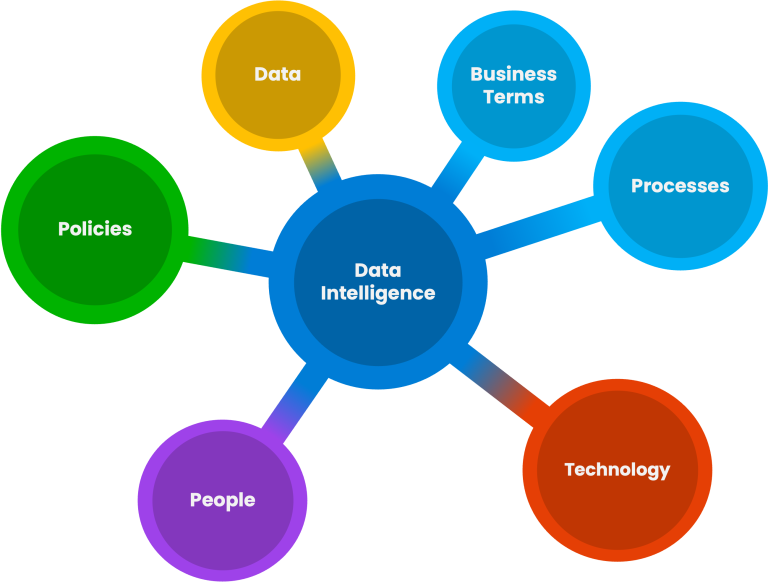Connecting the Dots with Data Intelligence
Lots of companies are using this tagline; “Connecting the Dots”. So do we. And why? What is “Connecting the Dots” for us, and why do we choose to use it even if it’s not so original?
By saying “Connecting the Dots on Data Intelligence”, we are referring to a Data Management Book of Knowledge (DMBOK) framework that helps us explain something quite complex in a very simple and easy to understand manner.
Here, we will explain our vision on connecting the dots around Data Intelligence. With the concept of Data Intelligence, we refer to actionable Data Governance: making sure we can find, understand and trust the data we use and also keeping track of this usage.
Data Intelligence: Role & Position
Data Intelligence is the connecting dot for all metadata (data about the different assets) of the other dots. Let’s begin with the Data dot.

Data
To implement Data Intelligence we capture the metadata of the data we have. We describe the schema’s, tables and columns a company has and where they reside. We capture details like technical data type and are able to classify the data that is stored in these tables. But the value is connecting these data assets to the actual definitions that the company uses; the business terms.
Business Terms
We make sure a company can use an unified language to make sure there is a common understanding of the terms that are being used. And we capture deviations when -for example- a business line needs to deviate from the common definitions. By connecting the business terms to the data we make sure it’s easy to understand what the business meaning is of the data that we are looking at. The collection of business terms we create is called the business glossary. And by making sure business terms are defined in the right way (we have our own guiding principles for this), we make sure that everyone in the business can use them.
Processes
Next to linking our information about Data to their meaning, it makes sense to link the data to processes. Processes use data as their input, data is the output of processes and data can tell you about the performance of your process. By connecting the data to the process we first can tell which process is producing what data. This can be handy when there is a data quality issue or when we need to know who is responsible for this creation. In the same example about data quality we can tell which processes are being impacted by poor data quality. Because we also connect to the People part of the organisation, we instantly know who to warn that the input data is of bad quality.
Technology
By linking data to the technology where it is stored, we know the physical location of our data. But we can also tell a system owner (because we also connect systems to People) what kind of data is stored in the system he/she is responsible for. This can be very relevant when the data is privacy sensitive and/or needs a high level of security.
People
The most important factor in every organisation; the People. By assigning People/roles for people to Data, to business terms, to processes, to Technology and to policies we always know who is responsible for certain data. But also who is responsible for a process that produces the data. Or we can easily see who is the Subject Matter Expert for a certain system that is storing the data that you want to use. By assigning roles and keep track of the people fulfilling these roles and capturing them in a central system of record (like Collibra), we make sure that people in the business can always find the right people on the right (connected) subject.
Policies
Policies can be internal or external policies. For companies that are in highly regulated markets, like banks, insurance companies etc. policies like BCBS239, SolvencyII, IFRS etc. are important to comply with. We link the data that has to comply with the policy to the actual policies, but also to the business rules/data quality rules that come with the policy. Another example is GDPR data. The GDPR (General Data Protection Regulation) classification of data helps people that want to use this data in their processes, but can also show a system owner that there is sensitive data stored in his/her system and that certain security measures have to be in place.
Closing the loop – Become Data Intelligent
When we connect the dots as explained above, we are able to answer many questions from all different angles. And of course the question will be, where to start? How to show the value? How to get the people on board? This is what we call the implementation of Data Intelligence. Want to know more about how to get this done? Please feel free to reach out!
